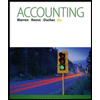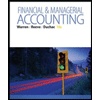
FIN + MANAG ACCT 180 DAY CUST CONN ACC
9th Edition
ISBN: 9781266114090
Author: Wild
Publisher: INTER MCG
expand_more
expand_more
format_list_bulleted
Concept explainers
Textbook Question
thumb_up100%
Chapter 1, Problem 2PSA
Problem 1-2A Computing missing information using accounting knowledge A1 P1
The following financial statement information is from five separate companies.
| Company |
A
B
C
D
E
Required
- Answer the following questions about Company A.
- What is the amount of equity on December 31, 2016?
- What is the amount of equity on December 31, 2017? Check ( 1b) $41,500
- What is the amount of liabilities on December 31, 2017?
- Answer the following questions about Company B.
- What is the amount of equity on December 31, 2016?
- What is the amount of equity on December 31, 2017?
- What is net income for year 2017? ( 2c) $1,600
- Compute the amount of assets for Company C on December 31, 2017. (3) $55,875
- Compute the amount of stock issuances for Company D during year 2017.
- Compute the amount of liabilities for Company E on December 31, 2016.
Expert Solution & Answer
Want to see the full answer?
Check out a sample textbook solution
Students have asked these similar questions
What is an example of a account that would be listed under current liabilities on a balance sheet and briefly explain why it would be categorized this way.
How would we categorize the balance in a notes payable account: under current liabilities or long-term liabilities? Why?
Can you explain this general accounting question using accurate calculation methods?
Get correct answer with accounting
Chapter 1 Solutions
FIN + MANAG ACCT 180 DAY CUST CONN ACC
Ch. 1 - Prob. 1QSCh. 1 - Prob. 2QSCh. 1 - Prob. 3QSCh. 1 - Prob. 4QSCh. 1 - Prob. 5QSCh. 1 - Prob. 6QSCh. 1 - Applying the accounting equation A1 Total assets...Ch. 1 - Applying the accounting equation A1 Use the...Ch. 1 - Prob. 9QSCh. 1 - Identifying effects of transactions using...
Ch. 1 - Identifying effects of transactions using...Ch. 1 - Prob. 12QSCh. 1 - Prob. 13QSCh. 1 - Identifying assets, liabilities, and equity P2...Ch. 1 - Prob. 15QSCh. 1 - Prob. 16QSCh. 1 - Prob. 17QSCh. 1 - Prob. 18QSCh. 1 - Prob. 19QSCh. 1 - Prob. 20QSCh. 1 - Prob. 21QSCh. 1 - Prob. 1ECh. 1 - Exercise 1-2 Identifying accounting users and uses...Ch. 1 - Prob. 3ECh. 1 - Prob. 4ECh. 1 - Prob. 5ECh. 1 - Prob. 6ECh. 1 - Prob. 7ECh. 1 - Prob. 8ECh. 1 - Exercise 1-8 Using the accounting equation A1...Ch. 1 - Exercise 1-9 Using the accounting equation...Ch. 1 - Prob. 11ECh. 1 - Exercise 1-10 Analysis using the accounting...Ch. 1 - Exercise 1-11 Identifying effects of transactions...Ch. 1 - Prob. 14ECh. 1 - Exercise 1-13 Identifying effects of transactions...Ch. 1 - Prob. 16ECh. 1 - Prob. 17ECh. 1 - Prob. 18ECh. 1 - Prob. 19ECh. 1 - Prob. 20ECh. 1 - Prob. 21ECh. 1 - Prob. 22ECh. 1 - Prob. 23ECh. 1 - Prob. 24ECh. 1 - Prob. 25ECh. 1 - Problem 1-1A Identifying effects of transactions...Ch. 1 - Problem 1-2A Computing missing information using...Ch. 1 - Prob. 3PSACh. 1 - Problem 1-4A preparing a statement of retained...Ch. 1 - Problem 1-5A Preparing a balances sheet P2
Use the...Ch. 1 - Problem 1-6A Preparing a statement of cash flows...Ch. 1 - Problem 1-7A Analyzing transactions and preparing...Ch. 1 - Problem 1-8.4 Analyzing effects of transactions C4...Ch. 1 - Prob. 9PSACh. 1 - Prob. 10PSACh. 1 - Prob. 11PSACh. 1 - Prob. 1PSBCh. 1 - Problem 1-2B Computing missing information using...Ch. 1 - Prob. 3PSBCh. 1 - Prob. 4PSBCh. 1 - Problem 1-5B Preparing a balance sheet P2 Use the...Ch. 1 - Prob. 6PSBCh. 1 - Prob. 7PSBCh. 1 - Problem 1-8B Analyzing effects of transactions C4...Ch. 1 - Prob. 9PSBCh. 1 - Prob. 10PSBCh. 1 - Prob. 11PSBCh. 1 - Prob. 1SPCh. 1 - Prob. 1.1AACh. 1 - Prob. 1.2AACh. 1 - Prob. 1.3AACh. 1 - Prob. 1.4AACh. 1 - Prob. 2.1AACh. 1 - Prob. 2.2AACh. 1 - Prob. 2.3AACh. 1 - Prob. 2.4AACh. 1 - Prob. 2.5AACh. 1 - Prob. 3.1AACh. 1 - Prob. 3.2AACh. 1 - Prob. 3.3AACh. 1 - Prob. 1DQCh. 1 - Technology is increasing used to process...Ch. 1 - Prob. 3DQCh. 1 - What are at least three questions business owners...Ch. 1 - Prob. 5DQCh. 1 - Describe the internal role of accounting for...Ch. 1 - 7. Identify three types of services typically...Ch. 1 - Prob. 8DQCh. 1 - Prob. 9DQCh. 1 - 10. What are some accounting-related professions?
Ch. 1 - Prob. 11DQCh. 1 - Prob. 12DQCh. 1 - Prob. 13DQCh. 1 - Prob. 14DQCh. 1 - Prob. 15DQCh. 1 - Prob. 16DQCh. 1 - Prob. 17DQCh. 1 - Prob. 18DQCh. 1 - Prob. 19DQCh. 1 - Prob. 20DQCh. 1 - Prob. 21DQCh. 1 - Prob. 22DQCh. 1 - Prob. 23DQCh. 1 - Prob. 24DQCh. 1 - Prob. 25DQCh. 1 - Prob. 26DQCh. 1 - Prob. 27DQCh. 1 - Define and explain return on assets.Ch. 1 - Prob. 1BTNCh. 1 - Prob. 2BTNCh. 1 - Prob. 3BTNCh. 1 - Prob. 4BTN
Knowledge Booster
Learn more about
Need a deep-dive on the concept behind this application? Look no further. Learn more about this topic, accounting and related others by exploring similar questions and additional content below.Similar questions
arrow_back_ios
SEE MORE QUESTIONS
arrow_forward_ios
Recommended textbooks for you
 Accounting (Text Only)AccountingISBN:9781285743615Author:Carl Warren, James M. Reeve, Jonathan DuchacPublisher:Cengage Learning
Accounting (Text Only)AccountingISBN:9781285743615Author:Carl Warren, James M. Reeve, Jonathan DuchacPublisher:Cengage Learning Financial & Managerial AccountingAccountingISBN:9781285866307Author:Carl Warren, James M. Reeve, Jonathan DuchacPublisher:Cengage Learning
Financial & Managerial AccountingAccountingISBN:9781285866307Author:Carl Warren, James M. Reeve, Jonathan DuchacPublisher:Cengage Learning AccountingAccountingISBN:9781337272094Author:WARREN, Carl S., Reeve, James M., Duchac, Jonathan E.Publisher:Cengage Learning,
AccountingAccountingISBN:9781337272094Author:WARREN, Carl S., Reeve, James M., Duchac, Jonathan E.Publisher:Cengage Learning,

Accounting (Text Only)
Accounting
ISBN:9781285743615
Author:Carl Warren, James M. Reeve, Jonathan Duchac
Publisher:Cengage Learning

Financial & Managerial Accounting
Accounting
ISBN:9781285866307
Author:Carl Warren, James M. Reeve, Jonathan Duchac
Publisher:Cengage Learning

Accounting
Accounting
ISBN:9781337272094
Author:WARREN, Carl S., Reeve, James M., Duchac, Jonathan E.
Publisher:Cengage Learning,
The ACCOUNTING EQUATION For BEGINNERS; Author: Accounting Stuff;https://www.youtube.com/watch?v=56xscQ4viWE;License: Standard Youtube License